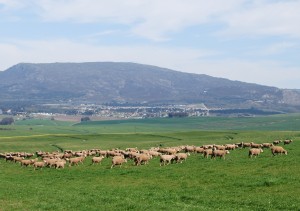CHAPTER < EIGHT - THE REBELLIOUS ATOM CONTD...
The Industrial Radiation Age
“Good evening comrades. All of you know that there has been an incredible misfortune – the accident at the Chernobyl nuclear plant. It has painfully affected the Soviet people, and shocked the international community. For the first time, we confront the real force of nuclear energy out of control.” These were the words of Soviet President Mikhail Gorbachev that first alerted the world to the worst nuclear power disaster that had ever occurred.
On 26 April 1986 on the eve of a long weekend, an experiment that had begun as an exercise to improve safety went horribly, terribly wrong. At 1:24 a.m. reactor no 4 of the Chernobyl Nuclear Power Station exploded in a blazing fireball, blowing off the reactor’s heavy steel and concrete lid. Spumes of radioactive material were released into the chill night air.
This radioactivity released in peacetime, was a hundred times more intense than that released by the Hiroshima and Nagasaki atomic bombs detonated during World War Two. The peaceful atom was no longer peaceful and the fearful results of the Industrial Radiation Age had come home to roost.
As fiery graphite, gaseous clouds of radioactive particles and steam spewed out of the stricken reactor, firemen on the ground and on the roof of the turbine building, knowing full well the danger they were in, battled to contain the raging beast that had been reactor no 4. Many of these firemen later paid for their amazing heroism with their lives. At grave risk also were the inhabitants of the atomic town of Prypiat, as well as thousands of farm labourers living and working on the fertile farmland within a dangerously close radius of the blazing reactor.
Yet the authorities, compounding the human errors of complacency, bad judgement, negligence, irresponsibility and gross mismanagement that had caused reactor no 4 to explode in the first place, placed an immediate embargo on all information about the explosion. It was only 48 hours later, and only after considerable pressure from the government of Sweden, that the Soviet authorities broke their silence.
Prior to the announcement by Soviet President Mikhail Gorbachev, there had been no warnings to the nearby people or anyone else for that matter, to protect them from the radioactivity of the plume billowing from the stricken nuclear power station. There were no warnings about the profound dangers of eating food or drinking water contaminated by radiation from the explosion’s fallout. There were no protective lids placed over drinking water wells.
 There were no trucks bringing in uncontaminated food, milk and water. There were no evacuations carried out for the villagers and townspeople now living within radioactively hot buildings. There were no medical precautions, such as handing out iodine to people living in the affected area, to be taken in order to prevent their thyroid glands from absorbing radioactive Iodine-131. There were in short, no protective or educative measures taken at all within those first two days of the explosion that could have improved the safety of the populations surrounding the stricken nuclear power station.
There were no trucks bringing in uncontaminated food, milk and water. There were no evacuations carried out for the villagers and townspeople now living within radioactively hot buildings. There were no medical precautions, such as handing out iodine to people living in the affected area, to be taken in order to prevent their thyroid glands from absorbing radioactive Iodine-131. There were in short, no protective or educative measures taken at all within those first two days of the explosion that could have improved the safety of the populations surrounding the stricken nuclear power station.
Eventually more than 100 000 people had to be evacuated from the radioactive hot zone and resettled elsewhere. And the rich farmland, over 1000 square kilometres of some of the most productive soil in the Ukraine, was contaminated to the point that it may never again yield crops for human or animal consumption.
Meanwhile the winds of the Northern Hemisphere had carried the deadly plume of radioactive debris across Europe, Scandinavia and other parts of the Soviet Union, scattering radioactive particles wherever it was blown. This carcinogenic cloud of uranium dioxide fuel and fission products eventually passed over 20 different countries dropping its lethal particles onto millions of people in these northern lands. The official death toll of the Chernobyl disaster was 31 people. However the actual number of people who have already or will still succumb to cancers and other horrific diseases caused as a result of exposure to Chernobyl’s radiation, will never be known.
In order to contain the still-raging beast of reactor No 4, an enormously thick sarcophagus of steel and concrete had to be built to enclose it. It is a dark sombre testament to humanity’s complacency with nuclear power; a complacency that led to the violation of six safety regulations, each one designed to prevent the unthinkable from occurring. These human errors, committed in a far-off corner of the Ukraine, resulted in incalculable human suffering across a wide range of northern countries. Such is the stealthy power of the rebellious atom.
 Radioactive particles are able to drift with the wind over a wide area to eventually settle unseen, unsmelled and untasted onto city pavements that children innocently skip along. Onto leafy vegetables growing in fields. Onto green grass that cows process into radioactively contaminated milk. Onto river sediments where it is absorbed into plants that are eaten by fish, which are then eaten by people. Onto trees and flowers and shrubs. Onto water and soil and pebbly beaches. Onto brick and plaster and wood. Onto wild animals and birds and insects. Onto people and pets and livestock. Until, unsuspected and undetected, these particles wreak their radiological havoc on everyone and everything onto which they have settled.
Radioactive particles are able to drift with the wind over a wide area to eventually settle unseen, unsmelled and untasted onto city pavements that children innocently skip along. Onto leafy vegetables growing in fields. Onto green grass that cows process into radioactively contaminated milk. Onto river sediments where it is absorbed into plants that are eaten by fish, which are then eaten by people. Onto trees and flowers and shrubs. Onto water and soil and pebbly beaches. Onto brick and plaster and wood. Onto wild animals and birds and insects. Onto people and pets and livestock. Until, unsuspected and undetected, these particles wreak their radiological havoc on everyone and everything onto which they have settled.
Once the rebellious atom is out of control there is no hiding place from its deadly energy force. And we know the dangers from past experience. Know that exposure to high levels of radiation causes people to suffer great psychological stress and to age prematurely. Know that it renders us unable to function or reproduce normally. Know that it destroys our natural system of immunity. Know that it makes us vulnerable and susceptible to cancers and other dreadful diseases. Know that irradiated land is land rendered unfit for agriculture or any other use at all for years and years to come.
Yet despite this, some nations of the world have increased and continue to increase the planetary level of radioactive pollution by the testing and detonation of still more atomic bombs. By the building of yet more nuclear power stations. By the mining and transport of more uranium fuel. But the nuclear problem does not stop there.
Perhaps even more insidious than these overt, well-known and dramatic applications of nuclear technology, are the widespread uses of radioactive materials in the production of a multitude of everyday household products. These are products such as Teflon-coated pans and high-gloss paper. A variety of foodstuffs that we eat every day are also irradiated to ensure that they are able to stay longer on the supermarket shelf.
 Worldwide, the level of background radiation has increased and is continuing to rise steadily. In this way it is adding its own considerable health threat to the problems already caused to humanity by daily exposure to some 200 000 chemicals such as cadmium, lead and mercury in the water that we drink, in the food that we eat, in the air that we breathe, and in the substances that we use to make life easier, better, faster.
Worldwide, the level of background radiation has increased and is continuing to rise steadily. In this way it is adding its own considerable health threat to the problems already caused to humanity by daily exposure to some 200 000 chemicals such as cadmium, lead and mercury in the water that we drink, in the food that we eat, in the air that we breathe, and in the substances that we use to make life easier, better, faster.
These are problems such as DNA and nervous-system damage, infertility, premature births, impaired immune system functioning, sickness and chronic disease, psychiatric symptoms, memory loss and even sexual orientation as caused by chemical oestrogens which upset the endocrine systems in humans, mimicking and interfering with the actions of natural hormones.
It seems that with our 21st Century lifestyle, there is no getting away from the rebellious atom. It is around us everywhere. The grave problem for the future is that, should global background radiation rise to a critical level either through continued nuclear testing and/or the uncontrolled use of radioactive materials, it could mean the eventual disappearance of the human species. In this situation whole generations of children would be so badly affected by rising background radiation levels that humanity’s gene-pool would be irreversibly damaged, which would eventually have the effect of wiping out the human race. The effects of this scenario would be long-term.
In a worst-case scenario, perhaps not as far-fetched as it would at first seem, where radiation levels exploded massively and instantaneously, either through aggressive confrontation or a devastating nuclear accident, there would literally be no place to hide. The result of this scenario would be immediate and total obliteration of our species and most other species as well. Whichever scenario potentially comes to pass, and of course it is fervently hoped that neither does, there can be no doubt that through the combined activities of many nations on Earth, we are wreaking radiological havoc on our own and future generations that are still to populate the planet. This is an indescribably horrible legacy for tomorrow’s children…